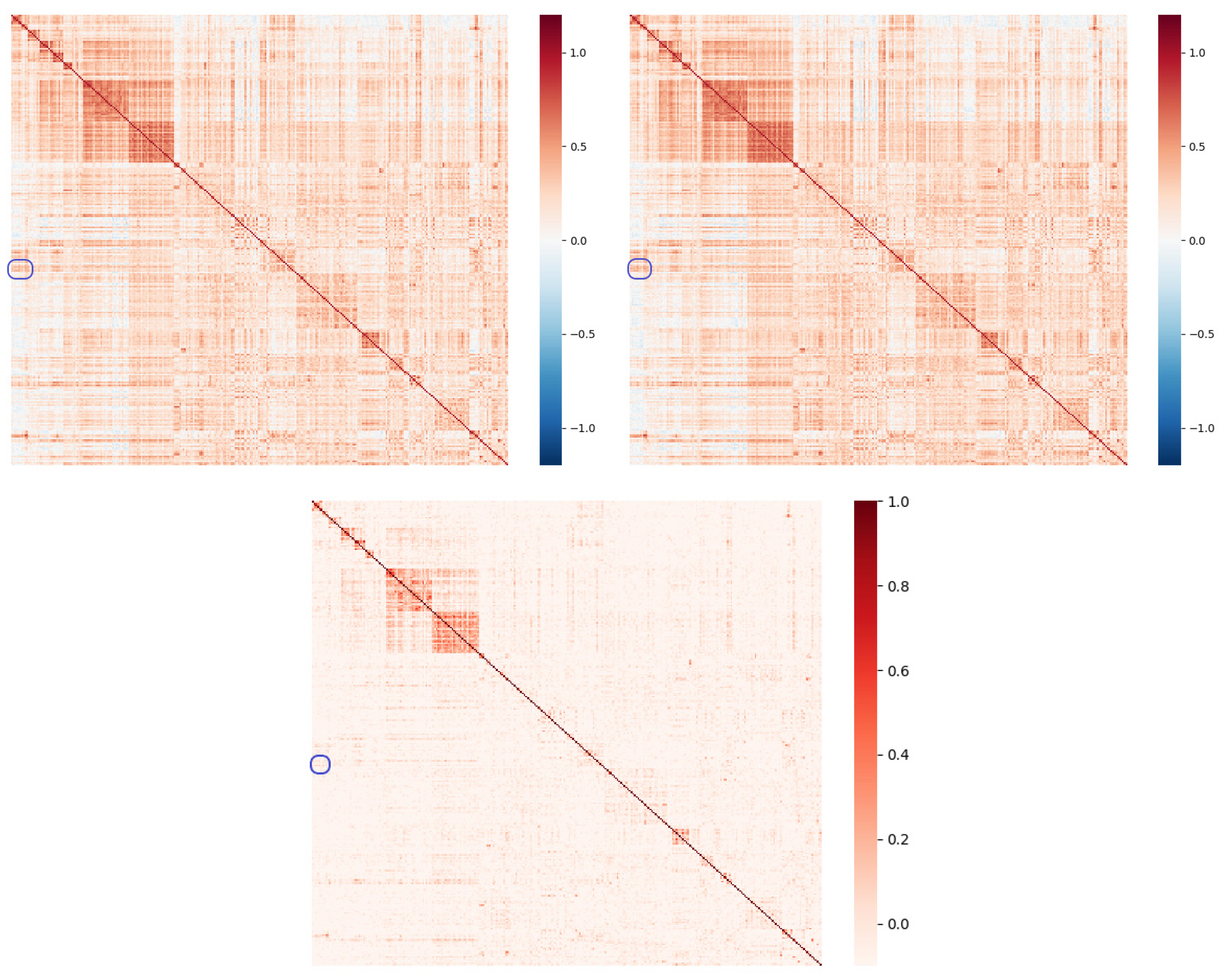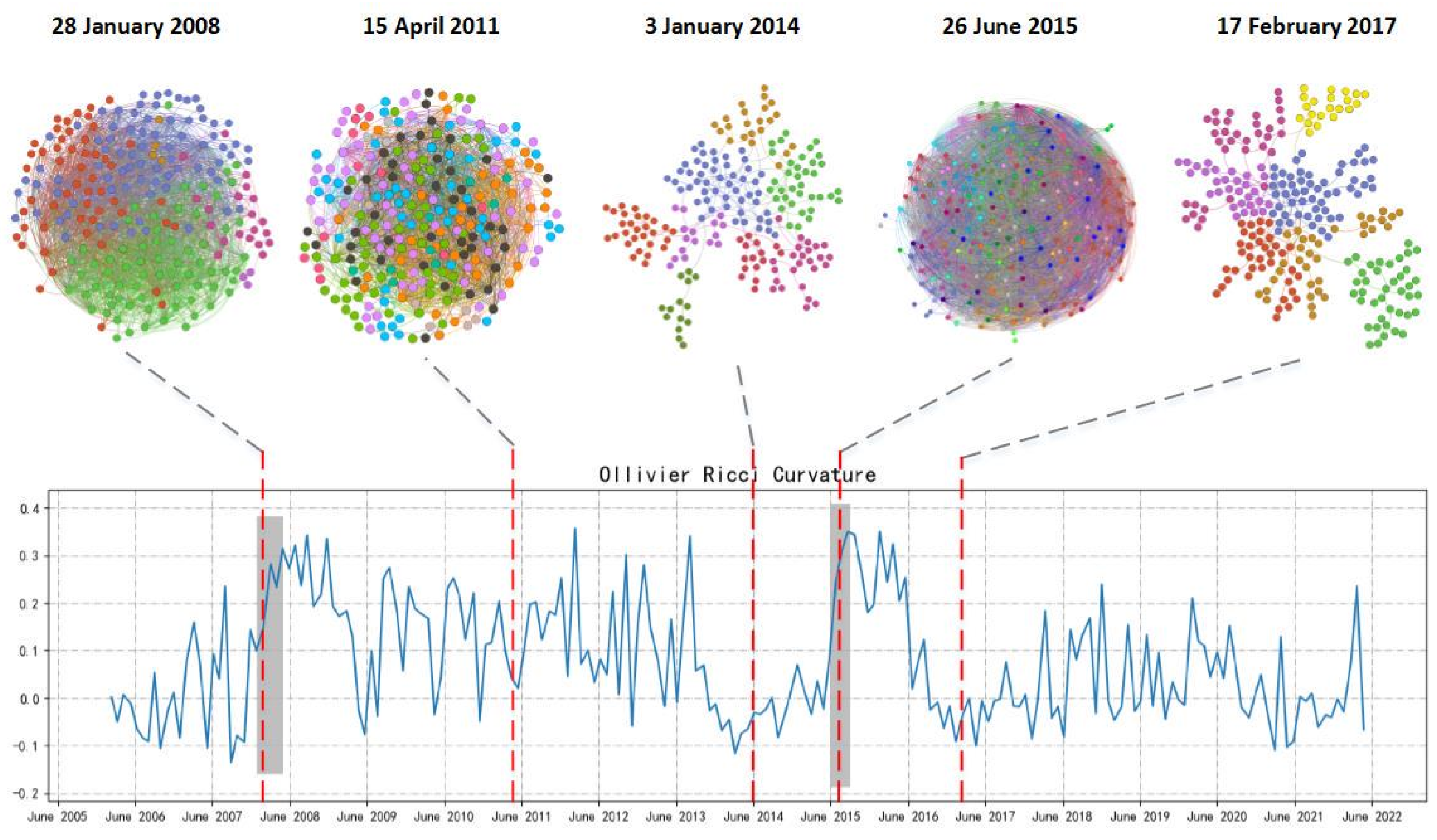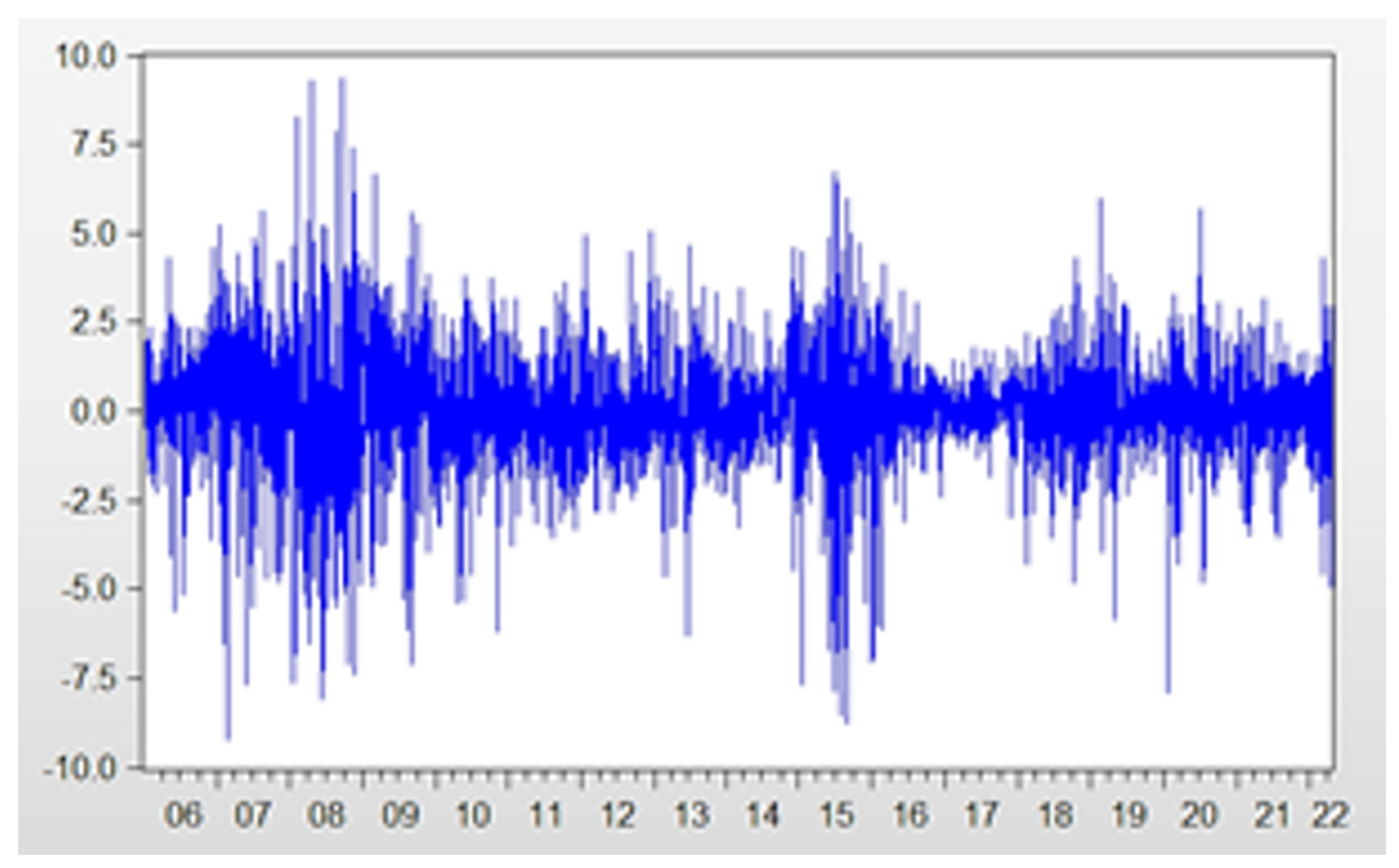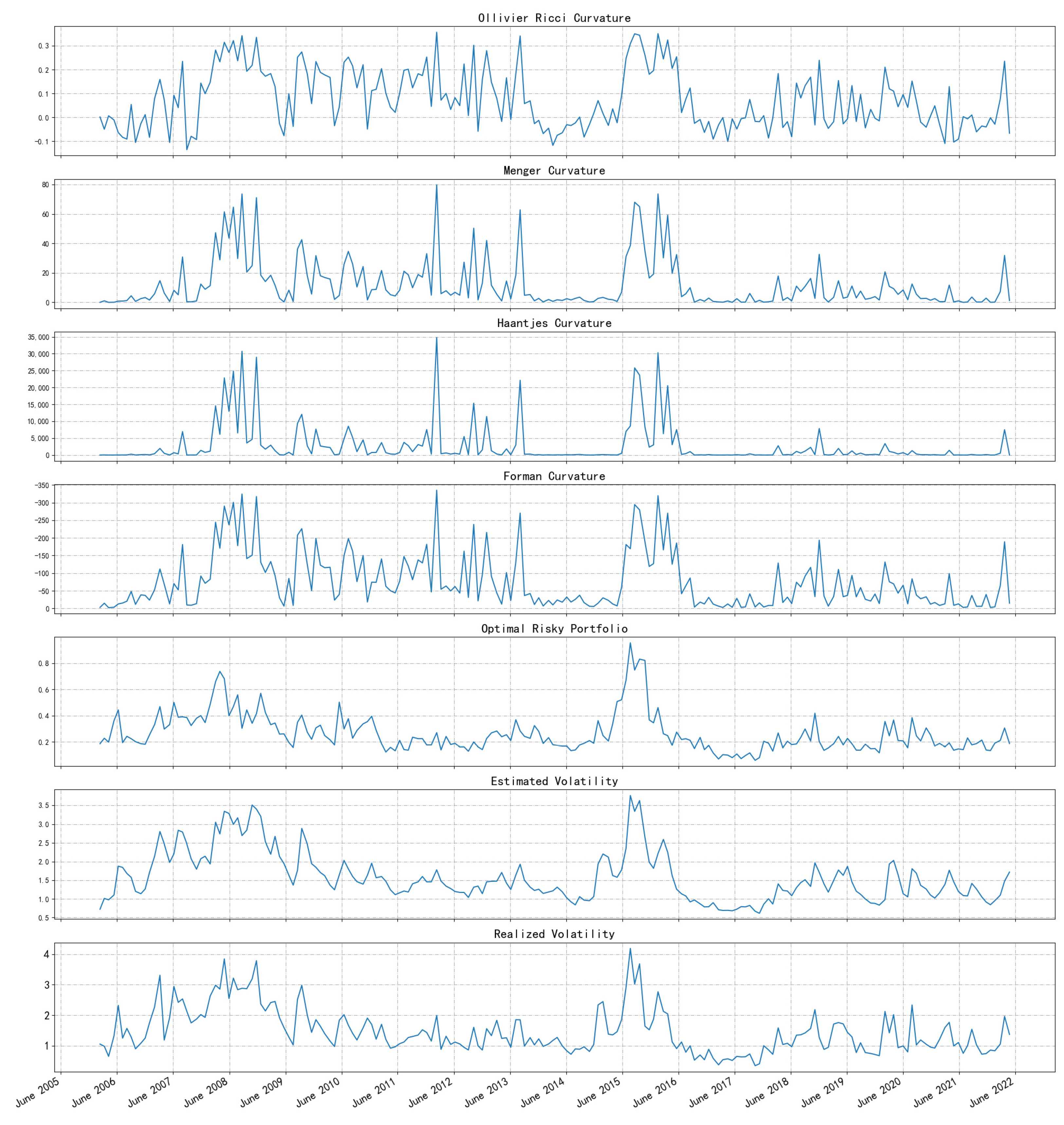Vulnerability Analysis Method Based on Network and Copula Entropy
Abstract
1. Introduction
2. Copula Entropy and Ricci Curvature
2.1. Nonlinear Causal and Information Captured with Copula Entropy
2.2. Market Vulnerability Measurement with Ricci Curvature
3. The Calculation of Curvature
4. Empirical Results and Analyses
4.1. CE and Correlation Coefficient
4.2. Network Analysis with CSI 300 Component Stocks
4.3. Comparison with Traditional Risk Metrics
4.4. Ability to Explain Returns
5. Conclusions
Author Contributions
Funding
Institutional Review Board Statement
Data Availability Statement
Conflicts of Interest
Appendix A
Appendix A.1. Ollivier–Ricci (OR)
Appendix A.2. Forman–Ricci (FR)
Appendix A.3. Menger–Ricci (MR)
Appendix A.4. Haantjes–Ricci (HR)
References
- Minsky, H.P. The Financial-Instability Hypothesis: Capitalist Processes and the Behavior of the Economy; Cambridge University Press: Cambridge, UK, 1982. [Google Scholar]
- Huang, J.L. On Financial Fragility. Financ. Res. 2001, 3, 41–49. [Google Scholar]
- Yang, H.B. Theoretical Analysis of Banking Crisis Transmission Mechanism. China Circ. Econ. 2008, 4, 77–80. [Google Scholar]
- Liu, H.Y.; Liu, J.Q. The Vulnerability Test of my country’s Stock Market in the Process of Emerging Market Change. Shanghai Econ. Res. 2013, 5, 69–74. [Google Scholar]
- Chang, X.X.; Zhou, Q.L. Research on the Relationship between Financial Fragility, Risk Management System and Financial Futures Market. China Secur. Futures 2019, 3, 4–8. [Google Scholar]
- Kaminsky, G.; Lizondo, S.; Reinhart, C.M. Leading indicators of currency crises. Staff Pap. 1998, 45, 1–48. [Google Scholar] [CrossRef]
- Lin, Y.; Wei, Y.; Cheng, H.W. Research on dynamic risk measurement of financial markets under asymmetric structure. Manag. Rev. 2012, 24, 18–25. [Google Scholar]
- Wang, Z.X. Construction and analysis of my country’s financial vulnerability indicators since the subprime mortgage crisis. Mod. Econ. Inf. 2017, 1, 299–300. [Google Scholar]
- Spelta, A.; Flori, A.; Pecora, N.; Pammolli, F. Financial crises: Uncovering self-organized patterns and predicting stock markets instability. J. Bus. Res. 2021, 129, 736–756. [Google Scholar] [CrossRef]
- Cerqueti, R.; Rotundo, G.; Ausloos, M. Investigating the configurations in cross-shareholding: A joint copula-entropy approach. Entropy 2018, 20, 134. [Google Scholar] [CrossRef] [PubMed]
- Cerqueti, R.; Rotundo, G. The weighted cross-shareholding complex network: A copula approach to concentration and control in financial markets. J. Econ. Interact. Coord. 2023, 18, 213–232. [Google Scholar] [CrossRef]
- Zhu, Y.; Yang, F.; Ye, W. Financial contagion behavior analysis based on complex network approach. Ann. Oper. Res. 2018, 268, 93–111. [Google Scholar] [CrossRef]
- Chen, X.; Hao, A.; Li, Y. The impact of financial contagion on real economy-An empirical research based on combination of complex network technology and spatial econometrics model. PLoS ONE 2020, 15, e0229913. [Google Scholar] [CrossRef]
- Battiston, S.; Puliga, M.; Kaushik, R.; Tasca, P.; Caldarelli, G. Debtrank: Too central to fail? financial networks, the fed and systemic risk. Sci. Rep. 2012, 2, 1–6. [Google Scholar]
- Haldane, A.G.; May, R.M. Systemic risk in banking ecosystems. Nature 2011, 469, 351–355. [Google Scholar] [CrossRef]
- Mantegna, R.N. Hierarchical structure in financial markets. Eur. Phys. J. B-Condens. Matter Complex Syst. 1999, 11, 193–197. [Google Scholar] [CrossRef]
- Onnela, J.P.; Chakraborti, A.; Kaski, K.; Kertesz, J.; Kanto, A. Dynamics of market correlations: Taxonomy and portfolio analysis. Phys. Rev. E 2003, 68, 056110. [Google Scholar] [CrossRef]
- Niu, X.J.; Wu, K.X. Review of Financial Market Interconnection and Risk Communication: From Time Series to Complex Network. Invest. Res. 2018, 37, 42–56. [Google Scholar]
- Chabot, M.; Bertrand, J.L. Complexity, interconnectedness and stability: New perspectives applied to the European banking system. J. Bus. Res. 2021, 129, 784–800. [Google Scholar] [CrossRef]
- Sandhu, R.; Georgiou, T.; Tannenbaum, A. Market fragility, systemic risk, and Ricci curvature. arXiv 2015, arXiv:1505.05182. [Google Scholar]
- Ma, J.; Sun, Z. Dependence Structure Estimation via Copula. arXiv 2008, arXiv:0804.4451. [Google Scholar] [CrossRef]
- Chen, L.; Singh, V.P.; Guo, S.; Zhou, J. Copula entropy coupled with artificial neural network for rainfall–runoff simulation. Stoch. Environ. Res. Risk Assess. 2014, 28, 1755–1767. [Google Scholar] [CrossRef]
- Hao, Z.; Singh, V.P. Integrating Entropy and Copula Theories for Hydrologic Modeling and Analysis. Entropy 2015, 17, 2253–2280. [Google Scholar] [CrossRef]
- Xu, P.; Wang, D.; Singh, V.P.; Wang, Y.; Wu, K.; Wang, L.; Zou, X.; Chen, Y.; Chen, X.; Liu, J. A two-phase copula entropy-based multiobjective optimization approach to hydrometeorological gauge network design. J. Hydrol. 2017, 555, 228–241. [Google Scholar] [CrossRef]
- Sklar, M. Fonctions de repartition an dimensions et leurs marges. Publ. Inst. Statist. Univ. Paris 1959, 8, 229–231. [Google Scholar]
- Li, X.M.; Shi, D.J. Correlation study of portfolio risk in financial markets. Syst. Eng. Theory Pract. 2007, 27, 112–117. [Google Scholar]
- Jondeau, E.; Rockinger, M. The copula-garch model of conditional dependencies: An international stock market application. J. Int. Money Financ. 2006, 25, 827–853. [Google Scholar] [CrossRef]
- Wen, Z.Q.; Feng, D.H. Empirical study on the volatility asymmetry of China’s stock market under the financial crisis. J. Daqing Norm. Univ. 2010, 30, 5. [Google Scholar]
- Virbickaitė, A.; Frey, C.; Macedo, D.N. Bayesian sequential stock return prediction through copulas. J. Econ. Asymmetries 2020, 22, e00173. [Google Scholar] [CrossRef]
- Ma, J.; Sun, Z. Mutual information is copula entropy. Tsinghua Sci. Technol. 2011, 16, 51–54. [Google Scholar] [CrossRef]
- Li, Y.L.; Gong, Y.J. Research on LSTM drought prediction model based on drive analysis. J. Math. Pract. Theory 2022, 360, 01093. [Google Scholar]
- Spearman, C. The american journal of psychology. Am. J. Psychol. 1904, 15, 88. [Google Scholar]
- Ma, J. Copula Entropy: Theory and Applications. ChinaXiv 2021. ChinaXiv:202105.00070. Available online: https://chinaxiv.org/abs/202105.00070 (accessed on 1 December 2023).
- Kraskov, A.; Stögbauer, H.; Grassberger, P. Estimating mutual information. Phys. Rev. E 2004, 69, 066138. [Google Scholar] [CrossRef]
- Samal, A.; Pharasi, H.K.; Ramaia, S.J.; Kannan, H.; Saucan, E.; Jost, J.; Chakraborti, A. Network geometry and market instability. R. Soc. Open Sci. 2021, 8, 201734. [Google Scholar] [CrossRef] [PubMed]
- De Long, J.B.; Shleifer, A.; Summers, L.H.; Waldmann, R.J. Positive feedback investment strategies and destabilizing rational speculation. J. Financ. 1990, 45, 379–395. [Google Scholar] [CrossRef]
- Stambaugh, R.F.; Yu, J.; Yuan, Y. Arbitrage asymmetry and the idiosyncratic volatility puzzle. J. Financ. 2015, 70, 1903–1948. [Google Scholar] [CrossRef]
- Sandhu, R.S.; Georgiou, T.T.; Tannenbaum, A.R. Ricci curvature: An economic indicator for market fragility and systemic risk. Sci. Adv. 2016, 2, e1501495. [Google Scholar] [CrossRef]
- Fama, E.F.; MacBeth, J.D. Risk, Return, and Equilibrium: Empirical Tests. J. Political Econ. 1973, 81, 607–636. [Google Scholar] [CrossRef]
- Sreejith, R.P.; Mohanraj, K.; Jost, J.; Saucan, E.; Samal, A. Forman curvature for complex networks. J. Stat. Mech. Theory Exp. 2016, 6, 063206. [Google Scholar] [CrossRef]
- Saucan, E.; Samal, A.; Jost, J. A simple differential geometry for complex networks. Netw. Sci. 2021, 9, S106–S133. [Google Scholar] [CrossRef]
- Saucan, E.; Samal, A.; Jost, J. A simple differential geometry for networks and its generalizations. In Proceedings of the Eighth International Conference on Complex Networks and Their Applications, Lisbon, Portugal, 10–12 December 2019. [Google Scholar]





| Panel A: Pearson Correlation Coefficient | Panel B: Spearman Correlation Coefficient | ||||||
| 600,489 | 601,899 | 603,993 | 600,547 | 601,899 | 603,993 | ||
| 600,352 | 0.40 | 0.44 | 0.40 | 600,352 | 0.31 | 0.45 | 0.40 |
| 600,426 | 0.33 | 0.44 | 0.46 | 600,426 | 0.20 | 0.49 | 0.43 |
| 600,989 | 0.34 | 0.38 | 0.40 | 600,989 | 0.15 | 0.34 | 0.39 |
| 601,216 | 0.36 | 0.43 | 0.41 | 601,216 | 0.17 | 0.45 | 0.41 |
| Panel C: CE | Panel D: Industries (from Shenwan) | ||||||
| 600,547 | 601,899 | 603,993 | Metallics: | ||||
| 600,352 | 0.04 | −0.01 | −0.06 | 600,547, 601,899, 603,993 | |||
| 600,426 | −0.05 | −0.07 | 0.00 | Basic chemical industry: | |||
| 600,989 | −0.09 | −0.03 | −0.01 | 600,352, 600,426, 600,989, 601,216 | |||
| 601,216 | −0.01 | 0.00 | 0.02 | ||||
| OR | MR | HR | FR | ORP | EVOL | VOL | |
|---|---|---|---|---|---|---|---|
| OR | 1 | ||||||
| MR | 0.8840 | 1 | |||||
| HR | 0.7445 | 0.9613 | 1 | ||||
| FR | −0.9354 | −0.9792 | −0.8936 | 1 | |||
| ORP | 0.5249 | 0.5285 | 0.4579 | −0.5342 | 1 | ||
| EVOL | 0.5861 | 0.6187 | 0.5477 | −0.6376 | 0.7975 | 1 | |
| VOL | 0.6215 | 0.6596 | 0.5939 | −0.6720 | 0.8225 | 0.9089 | 1 |
| Variable | Explanation | Computation |
|---|---|---|
| R | The excess return of a portfolio. | The 20-day return of a portfolio minus 20-day risk-free rate. |
| C | The curvature. | Ollivier–Ricci, Menger–Ricci, Haantjes–Ricci, and Forman–Ricci. |
| RF | Risk-free rate. | 3-month time deposit rate in China (in the 20-day term). |
| RM | Market factor. | For two-factor model: the excess return of CSI 300 index relative to the risk-free rate. For four-factor model: download from CSMAR directly. The excess return of the market considering reinvested cash dividends relative to risk-free rate. |
| SMB | Market value factor. | Download from CSMAR directly. The difference in return between the small-cap portfolio and the large-cap portfolio in A-share market. |
| HML | Book-to-market factor. | Download from CSMAR directly. The difference in return between the high book-to-market portfolio and the low book-to-market portfolio in A-share market. |
| CE | Pearson Coefficient | |||||||
|---|---|---|---|---|---|---|---|---|
| (1) | (2) | (3) | (4) | (5) | (6) | (7) | (8) | |
| R | R | R | R | R | R | R | R | |
| BO | −0.03 * | −0.02 * | ||||||
| (−1.95) | (−1.83) | |||||||
| BM | −4.34 *** | −3.97 * | ||||||
| (−2.65) | (−1.94) | |||||||
| BH | −1358.35 *** | −1121.69 ** | ||||||
| (−2.89) | (−2.00) | |||||||
| BF | 20.19 ** | 17.78 * | ||||||
| (2.25) | (1.95) | |||||||
| BRM | 0.00 | 0.00 | 0.00 | 0.00 | 0.01 | 0.01 | 0.01 | 0.00 |
| (0.24) | (0.34) | (0.45) | (0.31) | (0.74) | (0.74) | (0.86) | (0.68) | |
| _cons | −0.00 | −0.00 | −0.01 | −0.00 | −0.01 | −0.01 | −0.01 | −0.01 |
| (−0.46) | (−0.52) | (−0.79) | (−0.44) | (−0.82) | (−0.82) | (−1.05) | (−0.71) | |
| N | 29,546 | 29,546 | 29,546 | 29,546 | 28,045 | 28,045 | 28,045 | 28,045 |
| adj. R2 | 4.43% | 4.33% | 4.21% | 4.61% | 6.41% | 6.22% | 5.64% | 6.58% |
| CE | Pearson Coefficient | |||||||
|---|---|---|---|---|---|---|---|---|
| (1) | (2) | (3) | (4) | (5) | (6) | (7) | (8) | |
| R | R | R | R | R | R | R | R | |
| BO | −0.02 | −0.02 | ||||||
| (−1.46) | (−1.41) | |||||||
| BM | −5.05 *** | −3.46 | ||||||
| (−2.94) | (−1.59) | |||||||
| BH | −1661.89 *** | −1314.53 ** | ||||||
| (−3.28) | (−2.10) | |||||||
| BF | 20.10 ** | 14.51 | ||||||
| (2.26) | (1.59) | |||||||
| BRM | −0.00 | −0.00 | −0.00 | −0.00 | 0.00 | 0.00 | 0.01 | 0.00 |
| (−0.27) | (−0.20) | (−0.12) | (−0.20) | (0.70) | (0.78) | (0.83) | (0.72) | |
| BSMB | −0.00 | −0.00 | −0.00 | −0.00 | −0.00 | −0.00 | −0.00 | −0.00 |
| (−0.97) | (−1.06) | (−1.07) | (−1.06) | (−0.65) | (−0.77) | (−0.81) | (−0.74) | |
| BHML | −0.00 | −0.00 | −0.00 | −0.00 | −0.00 | −0.00 | −0.00 | −0.00 |
| (−0.40) | (−0.35) | (−0.29) | (−0.38) | (−0.14) | (−0.22) | (−0.24) | (−0.14) | |
| _cons | −0.00 | −0.00 | −0.00 | −0.00 | −0.00 | −0.00 | −0.00 | −0.00 |
| (−0.01) | (−0.19) | (−0.27) | (−0.05) | (−0.53) | (−0.66) | (−0.77) | (−0.56) | |
| N | 19,039 | 19,039 | 19,039 | 19,039 | 19,276 | 19,276 | 19,276 | 19,276 |
| adj. R2 | 16.57% | 16.76% | 16.84% | 16.71% | 14.47% | 14.46% | 14.02% | 14.63% |
| CE | Pearson Coefficient | |||||||
|---|---|---|---|---|---|---|---|---|
| (1) | (2) | (3) | (4) | (5) | (6) | (7) | (8) | |
| R | R | R | R | R | R | R | R | |
| 1 | −0.03 * | −4.67 *** | −1446.44 *** | 21.73 ** | −0.02 | −3.10 | −859.74 * | 13.74 |
| (−1.95) | (−2.85) | (−3.18) | (2.39) | (−1.66) | (−1.64) | (−1.69) | (1.62) | |
| 2 | −0.02 | −3.81 ** | −1167.05 ** | 18.15 * | −0.01 | −2.08 | −455.16 | 10.45 |
| (−1.57) | (−2.26) | (−2.53) | (1.98) | (−1.21) | (−1.16) | (−0.94) | (1.31) | |
| 3 | −0.02 | −3.38 ** | −1123.39 ** | 13.98 * | −0.02 | −2.87 * | −834.31 * | 12.48 * |
| (−1.18) | (−2.24) | (−2.52) | (1.73) | (−1.58) | (−1.78) | (−1.86) | (1.69) | |
| 4 | −0.03 ** | −5.06 *** | −1691.93 *** | 20.82 ** | −0.02 * | −3.44 * | −924.49 * | 14.68 * |
| (−2.02) | (−3.19) | (−3.60) | (2.49) | (−1.87) | (−1.90) | (−1.81) | (1.84) | |
Disclaimer/Publisher’s Note: The statements, opinions and data contained in all publications are solely those of the individual author(s) and contributor(s) and not of MDPI and/or the editor(s). MDPI and/or the editor(s) disclaim responsibility for any injury to people or property resulting from any ideas, methods, instructions or products referred to in the content. |
© 2024 by the authors. Licensee MDPI, Basel, Switzerland. This article is an open access article distributed under the terms and conditions of the Creative Commons Attribution (CC BY) license (https://creativecommons.org/licenses/by/4.0/).
Share and Cite
Chen, M.; Liu, J.; Zhang, N.; Zheng, Y. Vulnerability Analysis Method Based on Network and Copula Entropy. Entropy 2024, 26, 192. https://doi.org/10.3390/e26030192
Chen M, Liu J, Zhang N, Zheng Y. Vulnerability Analysis Method Based on Network and Copula Entropy. Entropy. 2024; 26(3):192. https://doi.org/10.3390/e26030192
Chicago/Turabian StyleChen, Mengyuan, Jilan Liu, Ning Zhang, and Yichao Zheng. 2024. "Vulnerability Analysis Method Based on Network and Copula Entropy" Entropy 26, no. 3: 192. https://doi.org/10.3390/e26030192
APA StyleChen, M., Liu, J., Zhang, N., & Zheng, Y. (2024). Vulnerability Analysis Method Based on Network and Copula Entropy. Entropy, 26(3), 192. https://doi.org/10.3390/e26030192






